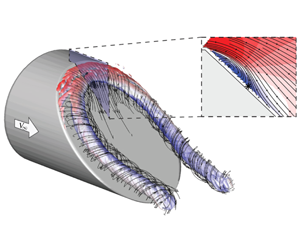Article contents
Reynolds number and slant angle effects on the flow over a slanted cylinder afterbody
Published online by Cambridge University Press: 21 April 2020
Abstract

The cylinder with a slanted base is a simplified, canonical bluff body geometry that shares similarities to aircraft fuselages, which are known to produce a strong vortex pair due to their upswept afterbody. This work will examine in detail the surface flow and near-field characteristics of the flow over the slanted cylinder for slant angles of  $20^{\circ }$,
$20^{\circ }$,  $32^{\circ }$ and
$32^{\circ }$ and  $45^{\circ }$ with spatially dense measurements. Principal flow features of the mean flow field are identified, showing the connection between the main counter-rotating vortex pair observed in the wake and the separation bubble observed at the leading edge of the slant. A full reconstruction of the three-dimensional mean flow field using stacked stereoscopic particle image velocimetry reveals intricate details of this flow and clearly shows the direct connection between the two features. To our knowledge, this is the first direct measurement of the full three-dimensional flow topology for this geometry. The separation bubble length is found to be directly proportional to the slant angle and inversely proportional to the Reynolds number. Furthermore, the circulation within the primary vortex pair increases with increasing slant angle. This strengthening of the vortices is correlated to the form drag of this body in the vortex-dominated regime. A bi-stable steady-state wake is also observed in this flow at a low Reynolds number for the slant angle of
$45^{\circ }$ with spatially dense measurements. Principal flow features of the mean flow field are identified, showing the connection between the main counter-rotating vortex pair observed in the wake and the separation bubble observed at the leading edge of the slant. A full reconstruction of the three-dimensional mean flow field using stacked stereoscopic particle image velocimetry reveals intricate details of this flow and clearly shows the direct connection between the two features. To our knowledge, this is the first direct measurement of the full three-dimensional flow topology for this geometry. The separation bubble length is found to be directly proportional to the slant angle and inversely proportional to the Reynolds number. Furthermore, the circulation within the primary vortex pair increases with increasing slant angle. This strengthening of the vortices is correlated to the form drag of this body in the vortex-dominated regime. A bi-stable steady-state wake is also observed in this flow at a low Reynolds number for the slant angle of  $45^{\circ }$, where the formation of either a separated wake flow state or a vortex-dominated flow state is dependent upon initial conditions, i.e. the presence of overshoot of the free-stream velocity during wind tunnel start-up.
$45^{\circ }$, where the formation of either a separated wake flow state or a vortex-dominated flow state is dependent upon initial conditions, i.e. the presence of overshoot of the free-stream velocity during wind tunnel start-up.
JFM classification
- Type
- JFM Papers
- Information
- Copyright
- © The Author(s), 2020. Published by Cambridge University Press
References
Zigunov et al. supplementary movie 1
Time-lapse of surface oil flow development for ɸ=32º and ReD=5×105.
- 31
- Cited by




